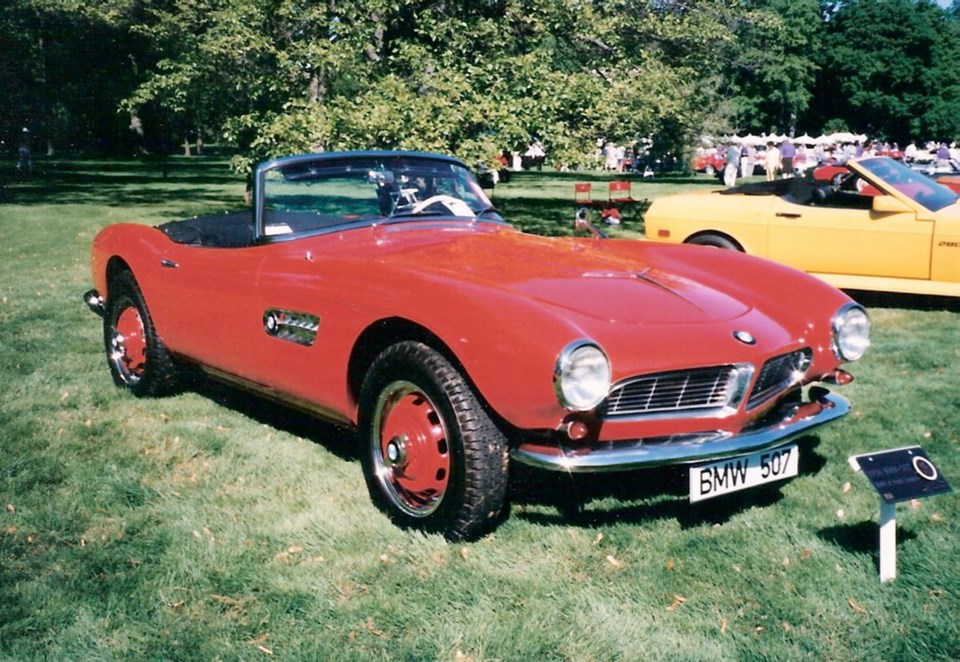BMW was unable to return to motor-vehicle production for a few years following the Second World War. Its car factory in Eisenach ended up in the Soviet zone under the 1945 Yalta Conference agreement in which Britain, France, the Soviet Union and United States divided Germany into four zones. The Eisenach plant was nationalized by the USSR.
BMW’s Munich motorcycle plant was in the American zone, and after a few years being restricted to making products such as pots and pans, they returned to motorcycle production. By 1952, they were able to start building cars there.
Its first postwar BMW 501 model was a rather bulbous sedan aimed at the upscale market. It was powered by BMW’s sturdy pre-war six-cylinder overhead-valve engine in which a clever crossover pushrod mechanism created hemispheric combustion chambers without the cost and complexity of overhead camshafts.
BMW had an aluminum overhead-valve V-8 under development, but not yet completed, so the expensive 501’s six-cylinder performance was uncompetitive with cars such as the English Jaguar Mark VII.
Their 2.6-litre V-8 was finally ready in 1954 and fitted to the 502 sedan, an evolution of the 501. The two models were not outstanding sellers, but did get BMW back into the car business.
They also acquired the rights and began building the tiny Italian Isetta “Bubble Car” in 1955. Although the Isetta hardly projected the image BMW sought to cultivate, they had to resort to anything that brought badly needed profit.
BMW wanted something more exciting to regain the panache of its outstanding pre-war 328 model. Others such as the Jaguar XK series, Mercedes-Benz’s stunning 300SL gullwing coupe and even the American Nash-Healey and Chevrolet Corvette were making their marks in the sports-car business.
BMW was encouraged to build a sports model by dealer Max Hoffman of New York, America’s premier imported-car distributor whose thumb was firmly on the pulse of the U.S. foreign car market. He had imported almost every marque and had strongly influenced Mercedes-Benz to produce the 300SL and 190SL sports cars. And Hoffman backed up his convictions with substantial orders.
The 503 and 507 two-seaters were BMW’s answer. Introduced at the 1955 Frankfurt Motor Show, the 503 was a touring car that came as a cabriolet or coupe. The 507, on the other hand, was a genuine open sports car with an optional removable steel top.
Both were styled by Albrecht Goertz, a renowned German-American designer who had, among other projects, worked with Raymond Loewy on the creation of the low and attractive Studebaker Starlight and Starliner coupes.
There was no contest between the two new BMWs; the 507 easily stole the show. While the 503 looked rather tall and old-fashioned with its BMW-trademark vertical split grille and horizontal body lines, the 507 was sleek, swoopy and taut. It was hard to believe this long-hood, short-deck beauty came from the same company as the egg-shaped Isetta.
The grille was split, but in a horizontal motif and stretched almost from headlight to headlight. It was canted forward at the top, giving the 507 a shark-like appearance.
The 507 was based on a shortened 501/502 chassis with a wheelbase of 2479 millimetres. Power came from the 502’s aluminum V-8, enlarged to 3.2 litres. It developed 155 horsepower and drove through a four-speed fully synchromesh manual transmission.
Suspension was independent, with A-arms in front and a solid axle at the rear, and longitudinal torsion bars and anti-roll bars front and rear.
With a weight of 1315 kilograms, the 507’s performance was quite competitive. Road & Track reported zero to 100 km/h in 8.8 seconds and an estimated top speed of 200 km/h. They judged the handling qualities “really excellent.”
The 507 was a beautiful image car for BMW, but alas, there were problems: delay and price. Due to limited production capacity, BMW was slow making it available in quantity. And when the 507 did come to North America two years after its Frankfurt introduction, it had a very high $9,000 price tag.
This made it uncompetitive against cars such as the Mercedes-Benz 300SL, which offered an outstanding racing heritage, higher performance, fuel injection and stunning styling, all with the mystique of those gullwing doors. And it cost about $7,500.
BMW built only 253 of its 507s from 1956 to 1959, and in spite of the high price, it’s questionable whether the company made money on it.
The 503 and 507 did not save BMW from its worsening financial woes. That task would fall to the stylish new small rear-engine 700, whose large block of orders helped rescue BMW from being swallowed up by rival Mercedes-Benz in 1959. But the 507 did leave a beautiful legacy.



